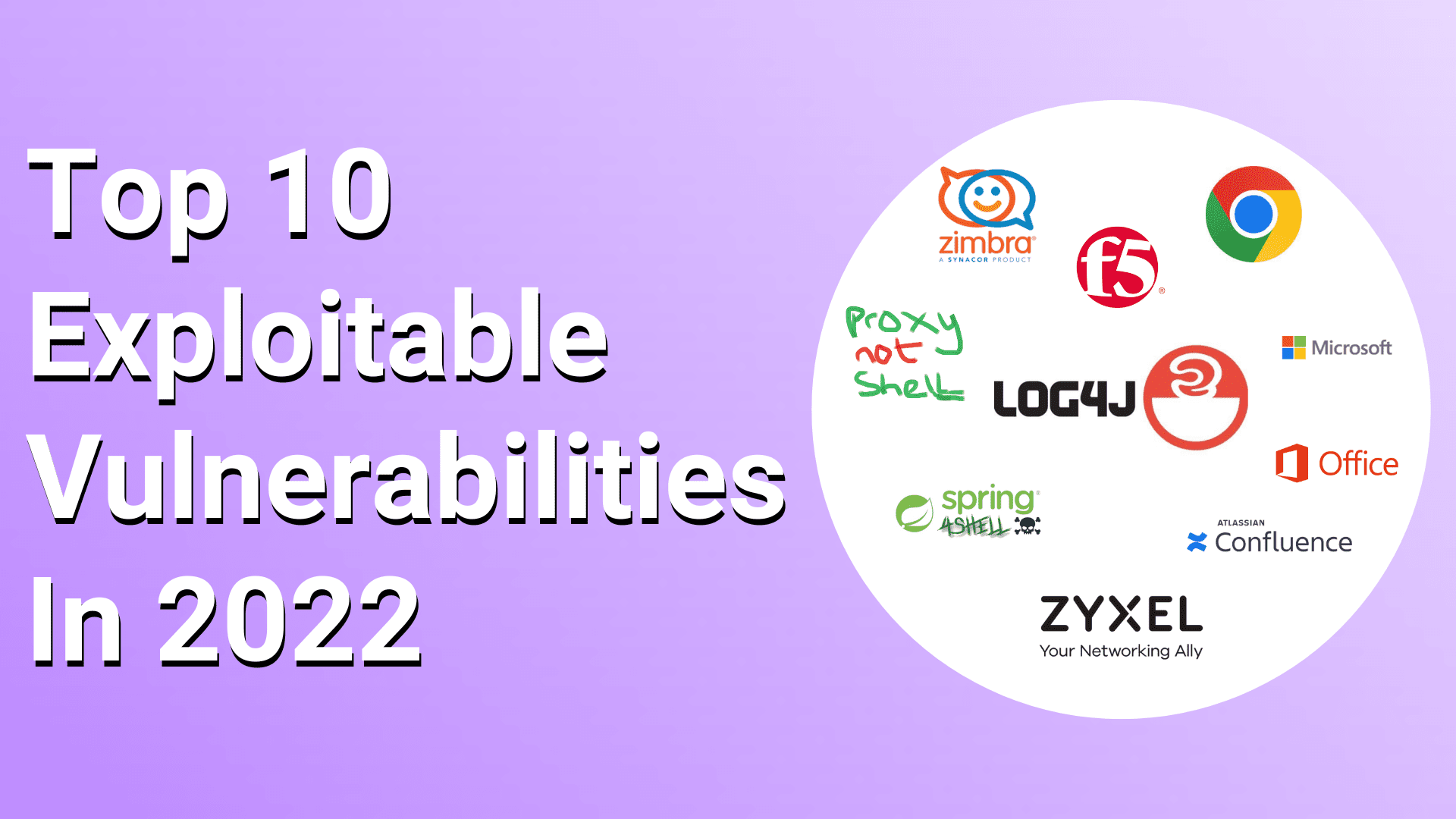Previous

Top 10 Most Exploited Security Vulnerabilities In 2022 (And How To Fix Them)
Learn about PurpleSec’s fully managed vulnerability management services.
Author: Dalibor Gašić / Last Updated: 12/16/2022
Reviewed By: Michael Swanagan, CISSP, CISA, CISM
View Our: Editorial Process
Table Of Contents
- Top Vulnerabilities In 2022
- Log4Shell (CVE-2021-44228)
- Follina (CVE-2022-30190)
- Spring4Shell (CVE-2022-22965)
- Google Chrome Zero-Day (CVE-2022-0609)
- F5 BIG-IP (CVE-2022-1388)
- Microsoft Office Bug (CVE-2017-11882)
- ProxyNotShell (CVE-2022-41082, CVE-2022-41040)
- Zimbra Collaboration Suite Bugs (CVE-2022-27925, CVE-2022-41352)
- Atlassian Confluence RCE Flaw (CVE-2022-26134)
- Zyxel RCE Vulnerability (CVE-2022-30525)
- How To Prevent The Top Vulnerabilities Of 2022
In the world of cyber security, vulnerabilities are an ongoing concern for individuals and organizations alike.
These weaknesses in software or hardware can be exploited by attackers to gain access to sensitive information or disrupt systems.
2022 saw its fair share of significant vulnerabilities that made headlines and affected a wide range of systems and devices.
These vulnerabilities impacted a wide range of systems and devices including:
- Web servers
- Collaboration platforms
- Office software
- Network devices
Some of the vulnerabilities were discovered and patched relatively quickly, while others remained unpatched for a longer period of time, leaving systems and devices at risk.
Top 10 Vulnerabilities In 2022
The top security vulnerabilities in 2022 include:
1. Log4Shell (CVE-2021-44228)
Log4Shell is a vulnerability in the logging component of the Apache Tomcat server software. It was discovered in 2021 and allowed attackers to execute arbitrary code on the server by sending a specially crafted request. The vulnerability was patched in a later version of Tomcat.
2. Follina (CVE-2022-30190)
Follina is a vulnerability in the popular web framework Ruby on Rails. It was discovered in 2022 and allowed attackers to execute arbitrary code on the server by sending a malicious request. The vulnerability was patched in a later version of Ruby on Rails.
3. Spring4Shell (CVE-2022-22965)
Spring4Shell is a vulnerability in the Spring framework, which is a popular Java-based web application framework. It was discovered in 2022 and allowed attackers to execute arbitrary code on the server by sending a malicious request. The vulnerability was patched in a later version of Spring.
4. Google Chrome Zero-Day (CVE-2022-0609)
This vulnerability was a zero-day exploit in the Google Chrome web browser. It was discovered in 2022 and allowed attackers to execute arbitrary code on the user’s system by convincing the user to visit a malicious website. The vulnerability was patched in a later version of Chrome, but many users were at risk until they update their browser.
5. F5 BIG-IP (CVE-2022-1388)
F5 BIG-IP is a network device used for load balancing and other purposes. It was discovered in 2022 that the device had a vulnerability that allowed attackers to execute arbitrary code on the device by sending a specially crafted request. The vulnerability was patched in a later version of the device’s software.
6. Microsoft Office Bug (CVE-2017-11882)
This vulnerability was a bug in the Microsoft Office software suite. It was discovered in 2017 and allowed attackers to execute arbitrary code on the user’s system by convincing the user to open a malicious file. The vulnerability was patched in a later version of Office.
7. ProxyNotShell (CVE-2022-41082, CVE-2022-41040)
ProxyNotShell was discovered in the popular proxy software HAProxy. They allowed attackers to execute arbitrary code on the server by sending a specially crafted request. The vulnerabilities were patched in a later version of HAProxy.
8. Zimbra Collaboration Suite Bugs (CVE-2022-27925, CVE-2022-41352)
These vulnerabilities were discovered in the Zimbra Collaboration Suite, a popular platform for email, calendar, and other collaboration services. They allowed attackers to execute arbitrary code on the server by sending a malicious request. The vulnerabilities were patched (8.8.15P31 and 9.0.0P24) in a later version of Zimbra.
9. Atlassian Confluence RCE Flaw (CVE-2022-26134)
This vulnerability was discovered in the Atlassian Confluence collaboration platform. It allowed attackers to execute arbitrary code on the server by sending a malicious request. The vulnerability was patched in a later version of Confluence.
10. Zyxel RCE Vulnerability (CVE-2022-30525)
This vulnerability affects Zyxel network devices and allows attackers to execute arbitrary code on the affected system, potentially allowing them to take control of the system or steal sensitive data. The vulnerability was discovered and patched in 2022, but it is still possible for systems that have not been updated to be at risk.
How To Prevent The Top Vulnerabilities Of 2022
- Keep software up to date: One of the most effective ways to protect against vulnerabilities is to keep all software up to date. This includes operating systems, web browsers, and any other applications you use. When software updates are released, they often include patches for known vulnerabilities, so it’s important to install them as soon as possible.
- Use strong passwords: Another way to protect against vulnerabilities is to use strong passwords for all accounts. This includes not only passwords for online accounts, but also passwords for local system accounts and devices such as routers. Use a mix of upper and lower case letters, numbers, and special characters, and avoid using the same password for multiple accounts.
- Be aware of potential threats: Stay informed about potential threats by following cyber security blogs and subscribing to alerts from security firms. This can help you stay aware of new vulnerabilities and take steps to protect yourself and your organization.
- Use security software: Using security software such as antivirus and firewall software can help protect against known vulnerabilities and prevent attacks. Make sure to keep this software up to date and configure it to receive automatic updates.
- Implement security best practices: Follow best practices for cyber security, such as using secure protocols for remote access, enabling two-factor authentication, and regularly backing up important data.
- Train employees: Educate employees about cyber security best practices and the importance of keeping systems and devices up to date. Encourage them to report any suspicious activity or potential vulnerabilities they encounter.
Wrapping Up
It’s important for individuals and organizations to stay informed about these types of vulnerabilities and take steps to protect themselves.
This includes keeping software up to date, using strong passwords, being aware of potential threats, using security software, and implementing security best practices.
By following these recommendations, individuals and organizations can better protect themselves from similar threats in the future. It’s also important to educate employees about cyber security best practices and the importance of keeping systems and devices up to date.
By working together, we can all play a role in protecting ourselves and our organizations from the ever-evolving threat of cyber security vulnerabilities.
Related Articles:

Dalibor Gašić
Dalibor is a Senior Security Engineer with experience in penetration testing having recently served over 8 years in the Ministry of Internal Affairs in the Department of Cyber Security in Serbia.
Recent Attacks
Popular Articles






 HEALTHCARE
HEALTHCARE GOVERNMENT
GOVERNMENT CRYPTO
CRYPTO